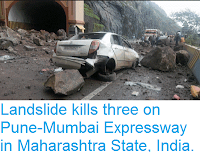Seven people are known to have died in flooding and other rain-related events in Maharashtra State, India on Tuesday 29 August 2017. Two people drowned in separate incidents in the city of Thane; one of whom has been identified as Gauri Jailwa, 14, and the second only as a 32-year-old-woman. In Mumbai, Kalyani Jangam, 2, died in a building collapse in the suburb of Vikhroli, and Nikhil Pal, 2, and Suresh Mourya, 40, died in a similar incident in the Panchasheel Chawl. Two more, as yet unnamed people are said to have died in a landslide in Vikhroli. Landslides are a common problem after severe weather events, as excess
pore water pressure can overcome cohesion in soil and sediments,
allowing them to flow like liquids. Approximately 90% of all landslides
are caused by heavy rainfall.
Flooding in Mumbai this week. Times of India.
The Mumbai area has been suffering its worst flooding since 2005, part of an exceptionally severe monsoon which has affected much of India this year. The floods have caused severe disruption to the city's transport network and other facilities, with airports closed due to the rains, many rail services suspended due to a series of landslides affecting train lines to and from the city, and many roads either flooded or blocked by abandoned cars. The majority of the city's schools have now closed, along with many other facilities and businesses, and there are concerns about the availability of drinking water in many parts of the city, and floodwaters are generally heavily tainted with rubbish.
Monsoons
are tropical sea breezes triggered by heating of the land during the
warmer part of the year (summer). Both the land and sea are warmed by
the Sun, but the land has a lower ability to absorb heat, radiating it
back so that the air above landmasses becomes significantly warmer than
that over the sea, causing the air above the land to rise and drawing in
water from over the sea; since this has also been warmed it carries a
high evaporated water content, and brings with it heavy rainfall. In the
tropical dry season the situation is reversed, as the air over the land
cools more rapidly with the seasons, leading to warmer air over the
sea, and thus breezes moving from the shore to the sea (where air is
rising more rapidly) and a drying of the climate. This situation is
particularly intense in South Asia, due to the presence of the
Himalayas. High mountain ranges tend to force winds hitting them
upwards, which amplifies the South Asian Summer Monsoon, with higher
winds leading to more upward air movement, thus drawing in further air
from the sea.
Diagrammatic representation of wind and rainfall patterns in a tropical monsoon climate. Geosciences/University of Arizona.
See also...
Follow Sciency Thoughts on Facebook.









